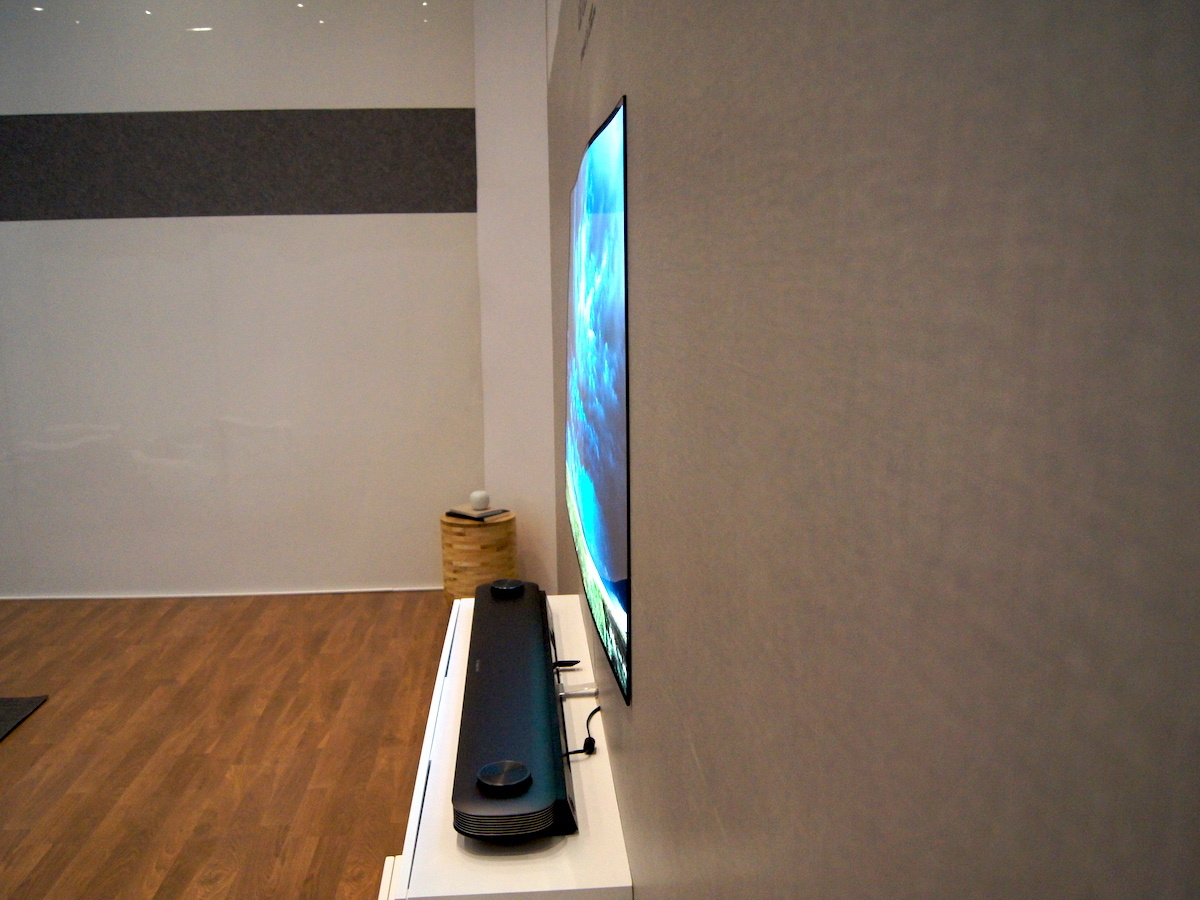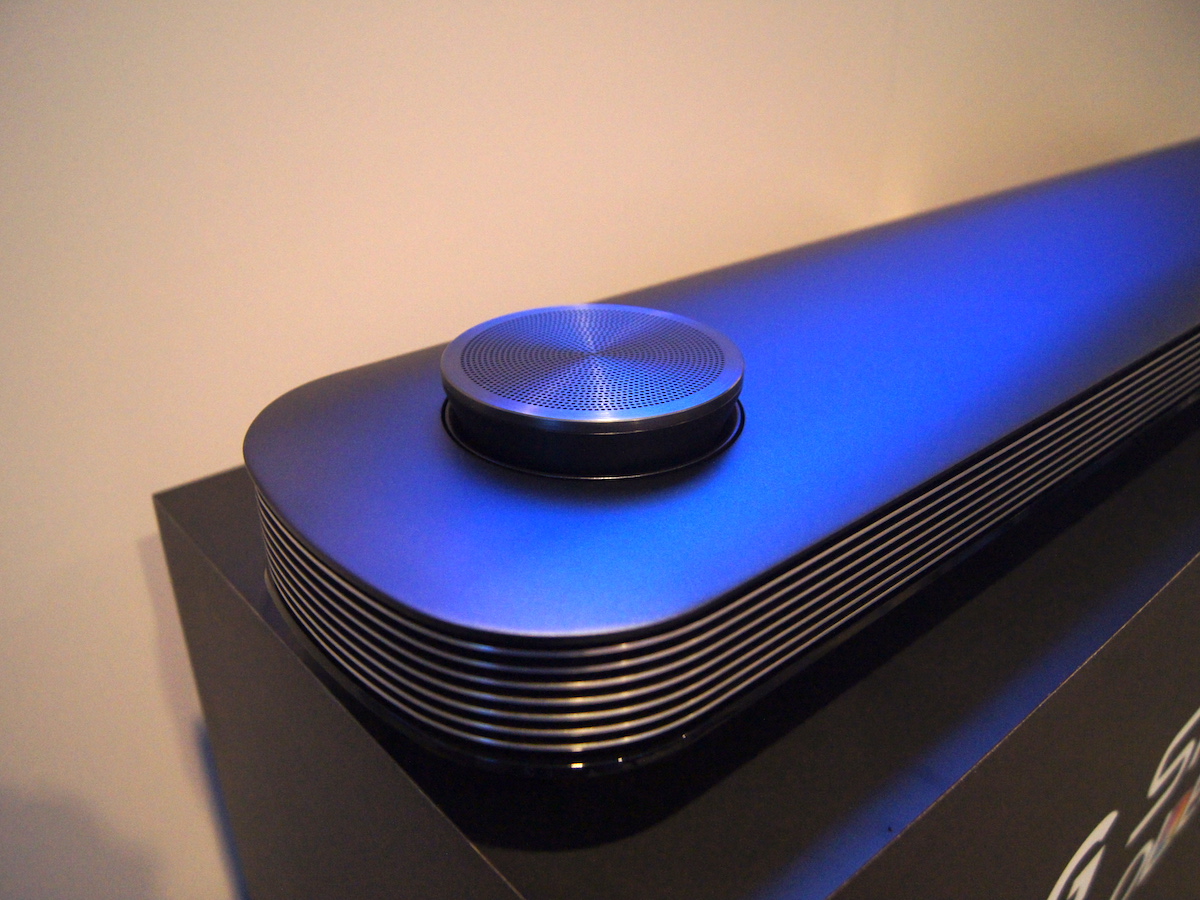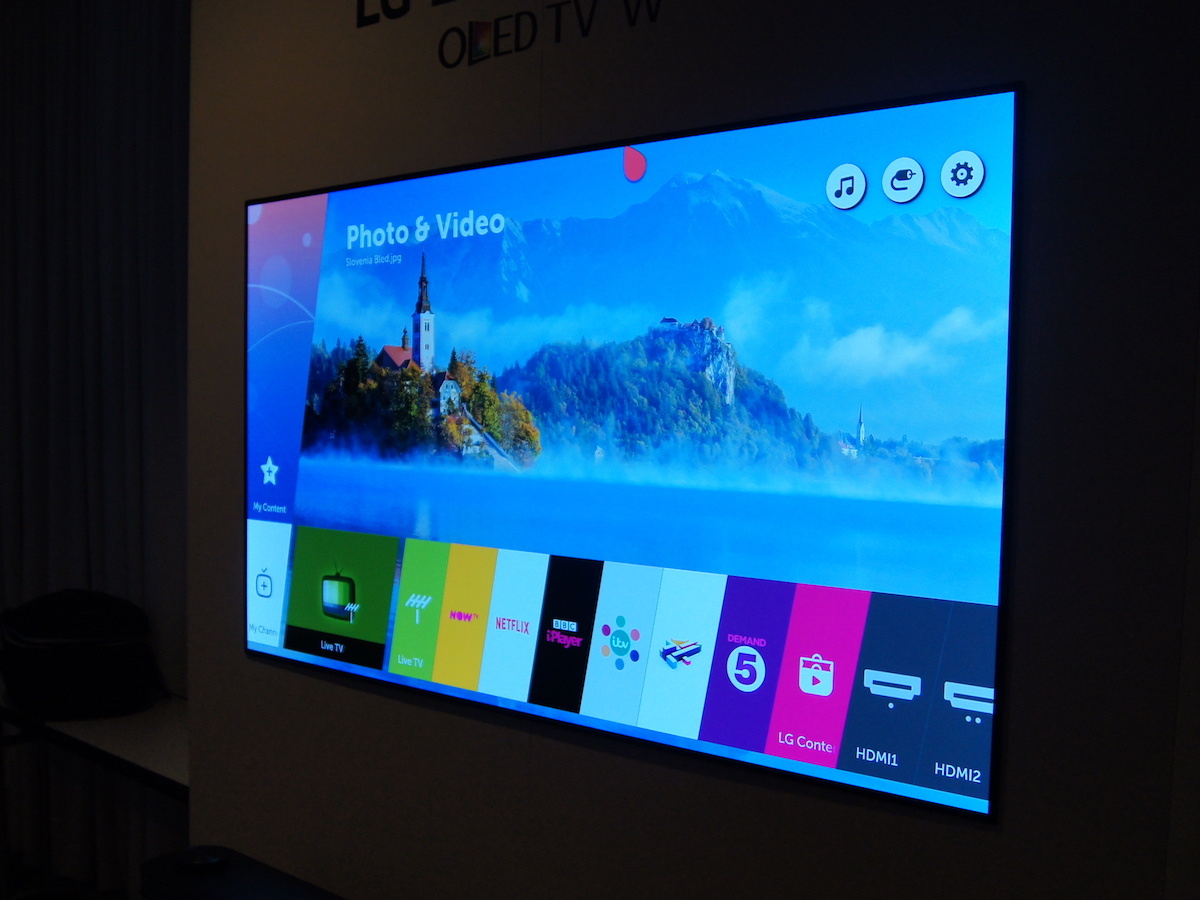LG Signature W7 Wallpaper OLED TV review
The new benchmark in TV design - and picture quality

It doesn’t happen nearly as regularly as you might imagine, but every once in a while something truly, breath-takingly awesome and original comes along to shake up a stagnating section of gadget land. LG’s ‘Wallpaper’ W7 TV is one such thing.
This is a TV that’s just 2.57mm thick, bendable and that clings to your wall with magnets.
It. Is. Astonishing.
But we already knew the design was amazing, having previously seen it at two separate events. Now, though, I’ve been able to put it through a proper test.
Before getting into the meat of the review, though, some housekeeping: due to the installation requirements of the W7 (it has to be wall-mounted), LG is not making review samples available as it usually would. Instead, the company invited me to review the TV in a hotel in San Francisco.
Clearly, this isn’t the ideal way to test a telly – I had about 5 hours with it rather than the couple of days I would usually take and I wasn’t able to test the built-in tuners – but I did have my own test materials, sources and tools and there was no interference from LG, so I do feel qualified to deliver a verdict. You might disagree, and that’s fine – just ignore the star rating and treat this piece as a really thorough and detailed hands-on. I’m sure you’ll still enjoy it.
Got all that? Then let me tell you that to my mind this breathtaking bit of design also delivers the best picture quality you can currently buy.
That isn’t to say there aren’t caveats, the key one being that you can get the same picture quality for much less by buying one of LG’s other 2017 OLEDs.
But if you did that you wouldn’t get a telly that looks like the W7 – and have I mentioned that it looks rather nice?
LG W7 design: the thinnest, coolest TV there’s ever been
2.57mm – that’s how thin the W7 TV is. A pound coin is thicker. Thanks to an extremely clever bracket, it still only sticks 4mm into your room when wall-mounted. I’d say it’s like having a picture frame on your wall, but a picture frame would be much thicker. It’s really more like turning a 65 or 77in section of your wall into a screen.
It’s bendy, too. No, that isn’t really useful – it’s just a side-effect of having a panel this thin – but peeling up one of the corners of your telly to show off to your mates is going to be absolutely priceless.
Of course, a TV isn’t only a screen – it’s also all of the inputs, outputs, speakers and processing gubbins, and the incredible thinness of the W7 means that these need to be housed in a separate unit. This soundbar-style device looks cool and has some neat features (pop-up speakers!) but it’s also been the subject of some strange design choices.
For example, while the screen has to be wall-mounted, the speaker unit can’t be, which means you’re going to need to put a shelf up or plonk it on a unit. It would be much cooler if it had a mounting solution so that it could essentially float a little way beneath the screen.
It obviously needs to be connected to the screen, too, and while the ribbon cable is nice and flat, it also looks quite conspicuous on anything but a white wall and it can’t be run within the wall itself.
Finally, should you decide you want to use a different speaker system (and you well might, but I’ll come to that), the W7’s soundbar is wide enough to be very awkward to find a hiding place for. It would be much simpler if LG offered a version of the TV with a speaker-less connection box for those who want to add their own sound system. In fact, it’s not ruling out going down that route in the future, but for now this is the only option.
Those are all just niggles though really, and as long as you’re happy to work within the W7’s constraints, you’re going to find yourself in possession of what is undoubtedly the coolest telly there’s ever been.
LG Signature W7 picture quality: the best just got better

Previously, all we’d ever seen on the W7’s screen was demo footage specifically designed to show it in the best possible light. Now I’ve been able to pump into it whatever I like, I can confirm that it’s an absolute stunner in the real world, too.
Kicking off with Mad Max: Fury Road on 4K Blu-ray (well you would, wouldn’t you?), the first thing that strikes you is how punchy the picture is. LG has actually increased the brightness of its OLEDs this year and you can really tell. Sure, a top-of-the-range LCD TV with an LED backlight will still go brighter, but HDR is about more than just brightness, and the way the W7 combines absolute blacks with its new brighter whites and colours makes for an image that’s utterly stunning.
Fury Road’s HDR transfer takes full advantage of this, and as the convoy of crazily-modded cars races across the desert your eyes are treated to piercing glints as the bright sunlight ricochets off the chrome, the strikingly saturated colours of the scorched landscape are warm and vibrant as you’ve never seen the them before, and the regular explosions are so vivid and punchy that you’re almost surprised to not feel the heat of them.
The storm the convoy enters is as dramatic as you can imagine, as the foreboding blackness is pierced by occasional brilliant, bright light and some beautiful red illumination, and the whole time the W7 is digging up every bit of detail, even in the shadowiest parts of the image.
And remember that because this is an OLED panel there’s no backlight involved, which means the darkness will never be ruined by clouding or patchiness. Black is black, white is white, and they can coexist in the same image without having any detrimental effect on one another.
Often the TV will select what it thinks is the best picture mode for the content you’re sending its way. Play something in HDR or Dolby Vision (which is even more impressive) and the TV will default to the Cinema Home mode. The Cinema mode is actually slightly more authentic, but it can look a little bit dark in a bright room, which is why the Cinema Home mode has the same overall settings but raises the average brightness so you get the full experience even in a normal living room.
There are a couple of settings to watch out for, though. Straight out of the box the TV will default to the Auto Power Save mode – you’ll want to ditch that immediately. You’ll also want to switch off the Energy Saving function – which adapts the panel’s brightness depending on the ambient light in the room – as it can make the image a bit too dim.
And then there’s the motion processing, which LG calls TruMotion. On some presets the Clear or Smooth option is automatically switched on. These are both horrible, introducing artefacts and the dreaded soap opera effect. The W7 doesn’t really need these extra motion processing modes at all. Switch them off and the motion is still very smooth and judder-free, and while there’s occasionally a smidge of blurring, it’s barely noticeable.
Of course, there are plenty of times that you’ll be watching something that isn’t 4K and doesn’t have HDR, and the W7 is a dab hand with this stuff, too. Skyfall in 1080p looks absolutely fantastic, with the LG digging up loads of detail, doing a fabulous job with the fairly neutral, nuanced colour palette, and using its inherent contrast abilities to make the image plenty punchy.
Want it to look even punchier? Try the HDR Effect setting. This analyses a scene to deepen the blacks and enhance the whites and colours. It’s essentially a contrast enhancer, but one that works surprisingly well. I can’t see this being something you’ll use for normal TV or watching football, but with a 1080p movie it’s well worth switching on.
LG Signature W7 gaming: glorious graphics and practically no input lag

Yes, of course I took a PS4 Pro with me to San Francisco for the test, and yes, Horizon Zero Dawn does look absolutely incredible on the W7.
The skyboxes are utterly stunning, masterfully avoiding the washing out that you find with other sets as they try to handle both dark and light at the same time. Here you get stunning sunlight and gorgeous god rays, but with clouds that are deep and textured and warmly coloured.
The same is true of the night scenes as well. There’s loads of insight into the dark areas as you lose little to no detail when using the W7, and the fabulous, werewolf-baiting skies have all of the drama you could hope for as a full moon emerges from foreboding clouds.
Detail is again exceptional, revealing the freckles on Aloy’s face, the intricacy of her eyes and the different textures used in her clothing.
Add an input lag of just 21ms when using the Game Mode and you’ve got perhaps the ultimate gaming monitor.
What is QLED? › Samsung’s new TV tech jargon busted
LG Signature W7 sound: great for a TV, not so great for a soundbar
Despite the looks and the presence of the Dolby Atmos logo, it’s actually best not to think of the W7’s speaker unit as a soundbar. If you did you’d probably expect room-filling sound with effects that seem as if they’re coming from above you. A real home cinema-style experience, if you like. That’s not what this LG gives you.
It’s actually designed to make it seem as though the sound is coming from the screen, but to sound much better than what you’d get from the sort of little speakers that are built into modern flatscreens.
Approached with those ambitions in mind, the W7’s sound is a success. This is crisp, clear audio with the sort of width and height that most TVs and a number of soundbars just can’t match. It feels like the sound isn’t just coming from the TV, but from the entire wall in front of you, which is very impressive.
At the same time, it doesn’t stretch into the room all that convincingly. Occasionally there’ll be a big effect that will feel as though it’s surrounding you a bit, but you don’t get the pin-point placement of effects or the sound above you that you might think you’re supposed to get from a Dolby Atmos soundbar.
On top of that, it also struggles quite a bit for bass weight and extension and, when combined with fairly flat dynamics, means that big effects often struggle for impact. When a big storm rolls in, the volume doesn’t shift up as it should and you don’t get the bassy thump or shudder you’re expecting.
Again, if the benchmark is average TV sound, this is a million miles better, but if you want glorious sound to match the glorious picture, you should consider a full speaker package or even a more capable one-box solution, such as the Atmos-toting Yamaha YSP-5600, which more convincingly delivers that virtual surround sound experience.
LG Signature W7 features: a million things to watch, all wrapped up in lovely webOS
Like every other 2017 LG TV, the W7 gets the the new version of webOS, 3.5. Honestly, not a huge amount has changed – but that’s ok because webOS is still one of the most welcoming and user-friendly TV operating systems out there.
If you’re still using a TV with dense, boring, black and white menus, webOS will be a revelation. This is a system full of colour and charm, with apps and features represented by little cards that can be easily rearranged in order of usefulness to you. Sources and apps are treated equally, and you even get shortcut buttons to Netflix and Amazon Video on the remote.
Speaking of the remote, it’s really rather lovely. It combines the features of the company’s existing Magic Remotes (so you can use it as motion-sensitive pointer) with a more traditional controller layout, and the result is a zapper that works well whether you’re a pointer or a clicker. It also feels great in the hand and uses some lovely, soft-touch materials. The direction buttons and central wheel/button in particular feel much nicer and are much more useable than they were on previous Magic Remotes.
LG has also added the ability to assign any source, app or feature to one of the remote’s number buttons, so iPlayer, for example, can be accessed by a long-press of 1, while your PS4 on HDMI 3 could be assigned to button 3. It’s an awesome little shortcut feature, although I wish you could also assign settings to one of the buttons. A Game Mode shortcut wold make this particular nerd very happy indeed.
In terms of what you’ve actually got to watch on your gorgeous new telly, the options are virtually endless. There are Freeview and Freesat tuners, plus Freeview Play for all of the usual catch-up TV. Netflix, Amazon Video, NowTV and YouTube are all built-in, and you even get Google Play Movies & TV so you can rent or buy the stuff that your subscription streaming services don’t have.
I also have to mention the OLED Gallery mode, but not because it’s good. This new feature of webOS 3.5 essentially turns your TV into a work of art by displaying some of the world’s most famous paintings on the panel. That would be fine, but it also adds virtual frames around the edges (and very cheesy plinky-plonk music if you don’t turn it off), and they look laughably naff. If you want to use your W7 as a digital picture frame – and it does make an absolutely brilliant one – just use the standard photo viewer. You can always download some Van Gogh to display in that mode.
Read more › every 2017 LG OLED TV detailed
LG Signature W7 verdict

The W7 is the best looking, most striking TV the world has ever seen. It also improves on the picture quality of last year’s OLEDs, which means it’s utterly stunning in action.
This is looking like a bumper year for brilliant TVs and LG is no longer the only purveyor of OLED, but we’re yet to get those other tellies to test and right now it’s very hard to find fault in the W7’s incredible picture, especially when watching or playing 4K HDR.
But here’s the thing: you can get the same picture for a lot less money by choosing one of LG’s other 2017 OLEDs. The B7 and C7 are going to come in at less than half the price of the W7, but they get exactly the same panel and processing tech so, even according to LG, the performance should be identical – only the sound and styling vary across the range.
All of which means the sensible money will be spent on a B7 or C7 (or maybe the slightly fancier E7 or G7).
But there are those lucky so-and-sos who don’t have to concern themselves with such trifling nonsense as how much things cost, and who can prioritise design and style. For those people the W7 is going to be almost impossible to resist, and if they buy one they’ll be getting an astonishing, beautiful, envelope-pushing piece of design – that just so happens to also be an incredibly good TV.
You might also like › LG’s entire 2017 OLED range explained
Tech specs
| Screen size | 65in (also available in 77in) |
| Display type | OLED |
| Resolution | 3840×2160 |
| Supported HDR formats | HDR10, Dolby Vision, HLG, Advanced HDR by Technicolor |
| Colour depth | 10-bit |
| Input lag in game mode | 21ms |
| Speaker power | 60W (4.2 channel) |
| Operating system | LG webOS 3.5 |
| Connections | HDMI (x4), optical out, USB (x3), aerial/satellite, ethernet, Wi-Fi |
| Tuners | Freeview (Freeview Play), Freesat |
| Key streaming services | Netflix, Amazon, Now TV, BBC iPlayer, ITV Player, All 4, Demand 5, YouTube, Google Play Movies & TV |
| Screen dimensions and weight | 83x145x0.3cm |
| AV unit dimensions and weight | 8x126x20cm |
Stuff Says…
Stunning design and stunning picture performance, but only the super-rich should even consider it
Good Stuff
Genuinely stunning design
All-round fabulous picture performance
Lovely to use
Packed full of apps and features
Sounds good by TV standards
Bad Stuff
But doesn’t sound great compared to a proper soundbar
Speaker section will be useless to some and is hard to hide
You can get the same picture quality for a lot less money









